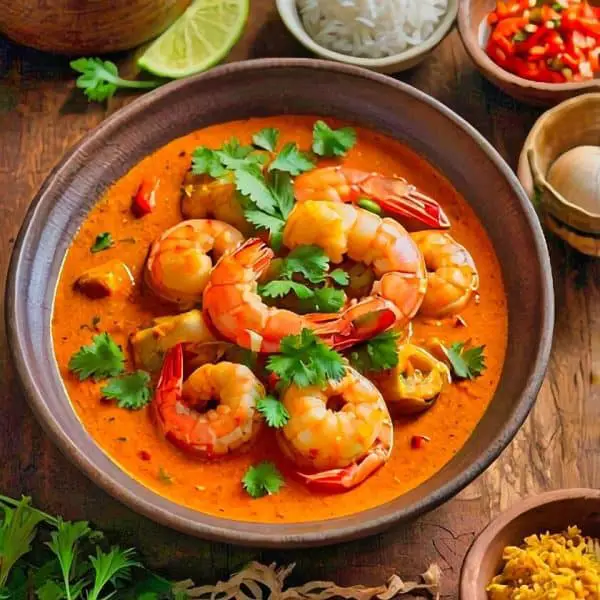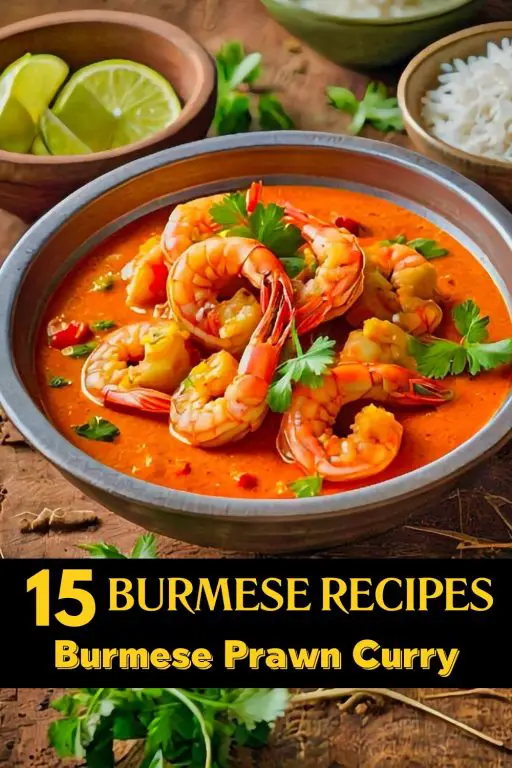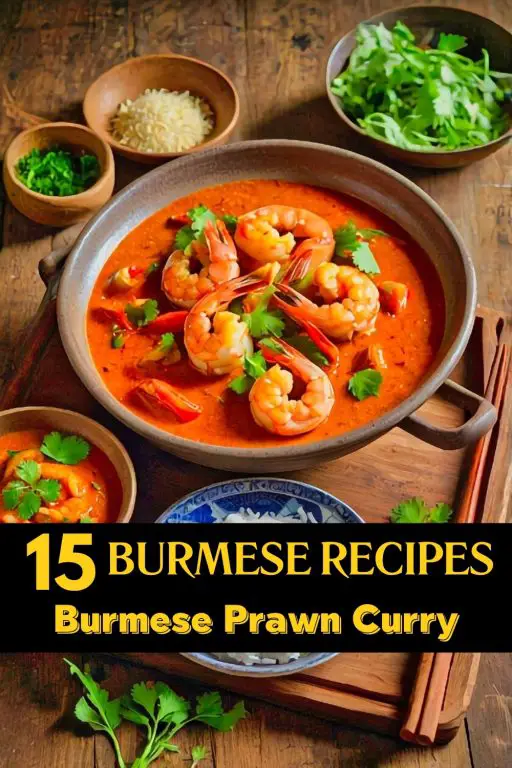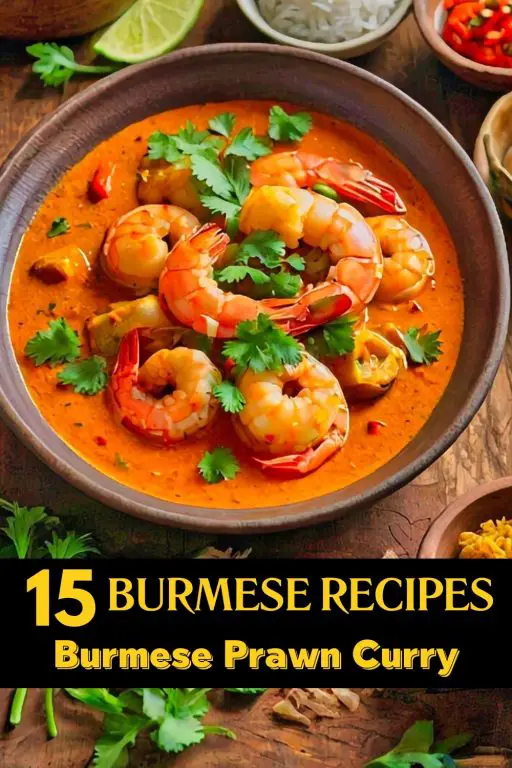The Burmese Prawn Curry recipe was one of my favorites from this trip where I tried to find new foods. Prawns are cooked in a curry sauce, which is known for being rich and spicy. I was especially interested in how this food fits in with eating healthy.
The Burmese Prawn Curry recipe is not only tasty, but it’s also good for you in a number of ways. When it comes to protein, prawns are a low-calorie source that is great for keeping muscle growth and keeping the body working well overall. Besides that, they have a lot of omega-3 fatty acids, which are good for your heart and help lower inflammation. Turmeric, which is often found in curry sauce, is known for its ability to reduce inflammation and protect cells from damage.
I learned that the recipe for Burmese Prawn Curry can be changed to make it healthier during my visit. If you make curry with less oil and more vegetables, for example, the meal will have more fiber and vitamins. You can also choose a lower-fat coconut milk or use a plant-based milk instead of coconut milk to lower the dish’s calorie and fat content without changing its smooth texture.
The restaurant gave me the recipe for Burmese Prawn Curry, which let me see how this dish can be changed to fit a better diet while still tasting like the real thing. With these changes, cooking it at home made it a delicious and healthy meal.
Ingredients For the Burmese Prawn Curry
Large Prawns
Diced Large Onion
Minced Garlic Cloves
Grated Ginger
Vegetable Oil
Fish Sauce
Ground Cumin
Ground Coriander
Ground Turmeric
Paprika
Chili Powder
Coconut Milk
Salt
Pepper to Taste
Cilantro for Garnish
Cooking Instructions For the Burmese Prawn Curry
- In a large pot or Dutch oven, heat the vegetable oil over medium heat.
- Add the diced onion and cook for 3-4 minutes until it becomes translucent.
- Add the minced garlic and grated ginger and cook for another 2-3 minutes until fragrant.
- Add the ground cumin, coriander, turmeric, paprika, and chili powder, and cook for 1-2 minutes until fragrant, stirring constantly.
- Add the prawns to the pot and cook for 2-3 minutes until they start to turn pink.
- Pour in the coconut milk and fish sauce, and stir well.
- Simmer the curry for 10-15 minutes until the prawns are fully cooked and the sauce has thickened to your liking.
- Season with salt and pepper to taste.
- Garnish with fresh cilantro and serve over steamed rice or noodles.
10 Reasons I love Burmese Food
Diverse Flavour Profiles
Burmese cuisine boasts a remarkable variety of flavours, from the tangy sharpness of fermented tea leaves in Laphet to the soothing warmth of coconut milk in Kaukswe. The balance between spicy, sweet, sour, and salty elements ensures that every meal offers a complex and satisfying taste experience. The use of ingredients like lemongrass, turmeric, and garlic further enriches the flavour spectrum, making each dish distinct and memorable.
Rich Use of Fresh Herbs and Spices
Fresh herbs like cilantro, mint, and basil, along with spices such as turmeric, ginger, and cumin, are central to Burmese cooking. These ingredients not only add depth and vibrancy to dishes but also enhance their nutritional value. The aromatic qualities of these herbs and spices create a sensory experience that is both refreshing and invigorating.
Unique Signature Dishes
Burmese cuisine is known for its iconic dishes, such as Mohinga (fish noodle soup), which is often regarded as the national dish. This rich, fragrant soup is a blend of fish, noodles, and spices, topped with crispy fritters and fresh herbs. Another standout is the Shan Noodles, featuring rice noodles in a spicy, savoury sauce. These unique dishes offer a taste of Burmese culture and tradition in every bite.
Versatility in Cooking Techniques
Burmese food showcases a range of cooking techniques, from stir-frying and boiling to steaming and deep-frying. This versatility allows for a diverse array of dishes, each prepared in a way that brings out the best in its ingredients. For example, the deep-fried fritters in Mohinga add a delightful crunch, while the steaming process in dishes like Kaukswe results in a soft, comforting texture.
Emphasis on Fresh and Local Ingredients
The use of fresh, locally-sourced ingredients is a hallmark of Burmese cuisine. Seasonal vegetables, herbs, and fruits are prominently featured, ensuring that meals are both flavourful and nutritious. This focus on local produce not only supports sustainability but also allows for a connection to the land and the people who grow the food.
Balanced Nutrition
Burmese meals are often well-balanced, incorporating a variety of food groups. For instance, a typical meal might include rice as a staple, accompanied by curries or stir-fries rich in proteins and vegetables. This combination provides a good mix of carbohydrates, proteins, and vitamins, contributing to a wholesome and satisfying diet.
Cultural and Historical Significance
Burmese food is deeply intertwined with the country’s history and culture. Many dishes have been passed down through generations, reflecting the traditions and culinary practices of different ethnic groups within Myanmar. Eating Burmese food provides a taste of this rich cultural heritage, making each meal a journey through history.
Comforting and Hearty Meals
Many Burmese dishes are known for their comforting and hearty qualities. Dishes like Kaukswe, with its rich coconut milk base and tender noodles, offer warmth and satisfaction. This comforting nature of Burmese food makes it ideal for both everyday meals and special occasions.
Affordable and Accessible
Burmese cuisine is often affordable, making it accessible to a wide range of people. Street food and local eateries offer delicious, budget-friendly options that allow people to enjoy authentic Burmese flavours without breaking the bank. This accessibility ensures that the cuisine can be enjoyed by everyone, regardless of their budget.
A Sense of Community
Sharing a meal of Burmese food is a social experience that brings people together. Whether it’s a family dinner or a gathering with friends, Burmese cuisine often features dishes that are meant to be shared, fostering a sense of community and connection. The communal nature of dining on dishes like Laphet and Mohinga highlights the importance of food in building relationships and creating memorable experiences.
Each of these reasons contributes to the deep appreciation and love for Burmese food, making it a cherished part of Myanmar’s cultural and culinary landscape.
5. Eating Healthy in Burma
Eating healthy in Burma, or Myanmar, is deeply intertwined with traditional dietary practices and a reliance on fresh, locally-sourced ingredients. The Burmese diet primarily revolves around rice, which serves as the staple component of most meals. This is typically accompanied by a variety of dishes that include vegetables, legumes, and lean proteins, reflecting a balanced approach to nutrition. Meals often feature an array of fresh vegetables such as leafy greens, beans, and squash, providing essential vitamins and minerals.
Burmese cuisine also incorporates a range of legumes and pulses, such as chickpeas and lentils, which are excellent sources of protein and fibre. Dishes like **Burmese chickpea salad** are not only nutritious but also showcase how traditional ingredients can be combined to create wholesome, satisfying meals. Additionally, seafood and lean meats are commonly used in curries and soups, contributing to a diet that includes a good balance of protein sources.
The use of herbs and spices, such as turmeric, ginger, and garlic, not only enhances flavour but also offers various health benefits. Turmeric, for example, contains curcumin, which is known for its anti-inflammatory properties. Similarly, garlic and ginger are known for their immune-boosting and digestive benefits.
Moreover, traditional Burmese meals often avoid excessive use of processed foods and sugars, focusing instead on whole, natural ingredients. This approach aligns with a healthy eating philosophy, promoting overall well-being. The traditional practice of using fresh ingredients and cooking methods such as steaming and boiling further supports a nutritious diet.
Overall, the emphasis on fresh produce, legumes, lean proteins, and beneficial spices in Burmese cuisine contributes to a balanced and health-conscious approach to eating. This traditional diet, rooted in local agricultural practices, offers a nutritious and satisfying way of eating that supports overall health and wellness.
FAQ For the Burmese Prawn Curry
Here are 5 FAQs with the keyword “Burmese Prawn Curry recipe”:
Q: What type of prawns are best for a Burmese Prawn Curry recipe?
A: For a Burmese Prawn Curry recipe, it is best to use large, fresh prawns with their shells removed for the best texture and flavor. Fresh prawns provide a juicier, more tender bite compared to frozen ones, though frozen prawns can be used if fresh are not available. Make sure to devein the prawns to avoid any gritty texture in the curry. The size of the prawns can also affect cooking time, so adjust accordingly to ensure they are cooked through.
Q: How can I adjust the richness of the sauce in a Burmese Prawn Curry recipe?
A: To adjust the richness of the sauce in a Burmese Prawn Curry recipe, you can modify the amount of coconut milk used. For a richer sauce, add more coconut milk or use full-fat coconut milk. If you prefer a lighter curry, opt for a reduced amount or use light coconut milk. Additionally, simmering the curry longer will allow the flavors to concentrate and the sauce to thicken.
Q: Can I use a different type of seafood in a Burmese Prawn Curry recipe?
A: Yes, you can substitute other types of seafood in a Burmese Prawn Curry recipe, such as fish, squid, or scallops. Each type of seafood will bring its own unique flavor and texture to the dish. Ensure that the cooking times are adjusted according to the seafood used to prevent overcooking. For example, fish may cook faster than prawns, so add it later in the cooking process.
Q: What spices are essential in a Burmese Prawn Curry recipe?
A: A Burmese Prawn Curry recipe typically includes spices such as turmeric, coriander, cumin, and chili powder to build its flavor profile. These spices are often combined with fresh ingredients like garlic, ginger, and lemongrass to create a fragrant base. Adjusting the quantities of these spices can help customize the heat and depth of flavor. The combination of these spices gives the curry its characteristic taste and aroma.
Q: How can I make a Burmese Prawn Curry recipe spicier or milder?
A: To make a Burmese Prawn Curry recipe spicier, increase the amount of chili powder or add fresh chilies to the curry. For a milder version, reduce the chili content and add extra coconut milk to balance the heat. You can also serve the curry with spicy condiments on the side, allowing diners to adjust the spice level to their taste. Balancing the spices with additional ingredients like sugar or vinegar can also help control the overall heat.

Burmese Prawn Curry
Equipment
- Large pot or Dutch oven
- Cutting board and knife
- Measuring Spoons
- Wooden spoon or spatula
- Can opener
Ingredients
- 2 lbs. Large prawns, peeled and deveined
- 1 large onion, diced
- 4 garlic cloves, minced
- 2 tbsp. grated ginger
- 2 tbsp. vegetable oil
- 2 tbsp. fish sauce
- 2 tsp. ground cumin
- 2 tsp. ground coriander
- 2 tsp. ground turmeric
- 2 tsp. paprika
- 1 tsp. chili powder
- 1 can coconut milk
- Salt and pepper to taste
- Fresh cilantro for garnish
Instructions
- In a large pot or Dutch oven, heat the vegetable oil over medium heat.
- Add the diced onion and cook for 3-4 minutes until it becomes translucent.
- Add the minced garlic and grated ginger and cook for another 2-3 minutes until fragrant.
- Add the ground cumin, coriander, turmeric, paprika, and chili powder, and cook for 1-2 minutes until fragrant, stirring constantly.
- Add the prawns to the pot and cook for 2-3 minutes until they start to turn pink.
- Pour in the coconut milk and fish sauce, and stir well.
- Simmer the curry for 10-15 minutes until the prawns are fully cooked and the sauce has thickened to your liking.
- Season with salt and pepper to taste.
- Garnish with fresh cilantro and serve over steamed rice or noodles.





1 comment
Every bite of this prawn curry was packed with flavor. I’ll definitely be making this again.
Comments are closed.